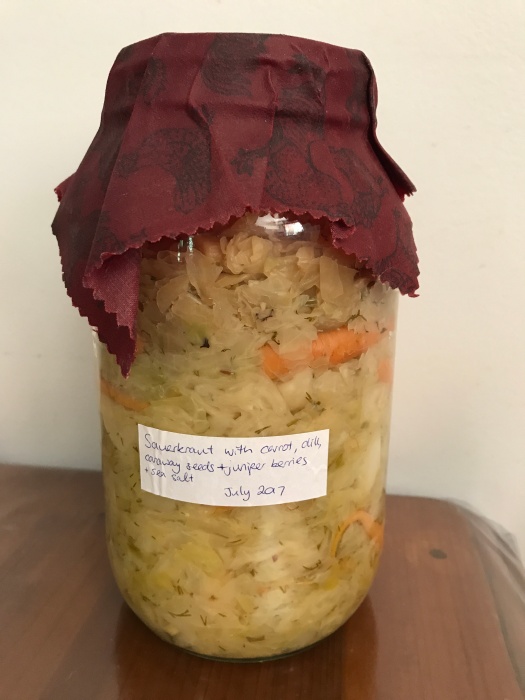You know when you don’t know how much you know?
This blog post at Treading my own Path gives a really good step-by-step guide to making sauerkraut in your kitchen without any fancy equipment.
It made me realise that I can now put together a batch of sauerkraut without too much fuss. I know the process well enough to enjoy chopping the cabbage, massaging it with salt and packing it into the jar, all while listening to a podcast.
Then it’s just a matter of letting the microbes do their work over time. Ferments are a good lesson in patience, a virtue that I could work on! They are also a great way to reuse glass jars, preserve food when it’s good, add beneficial gut bacteria to your microbiome, and make you feel like a boss in the kitchen.
After not too many batches I know which jar to use for one big head of cabbage, and which bottle fits nicely inside that jar to weigh the cabbage down. I have a separate bag of cloths in my rag bag just for covering ferments. I know the rules enough to bend them; adding different vegetables, herbs and spices that I think might taste good.
In this last batch I used fresh dill and some baby carrots. (I’ve lost the lid to this jar which is why it’s covered with a beeswax wrap.)

I had made sauerkraut once or twice before, but this year I read a book that has changed my life. It is The Art of Fermentation by Sandor Ellix Katz. It is a wonderful manifesto about microbes, food and food politics, human connection, traditions, and respecting life in all its forms (including microbial life.) I read paragraphs of it out loud to anyone who would listen and almost cried when returning it to the library. I try to think carefully before purchasing anything, but months later I’m still quoting it – so I think it may be a book I need to own.
Now I make sauerkraut regularly. Also yogurt. Cultured butter and buttermilk. I’ve fermented daikon radish with nasturtium leaves, olives from our tree, and brined nasturtium seed pods to make caper-like nuggets of goodness. I realised I have been fermenting grains for porridge for years. The Man and I are planning on fermenting our own beer at home. So many other things I want to try.
So if you are considering making your own sauerkraut, go forth and ferment! But beware – sauerkraut is a fermenting gateway, and you may not want to stop…

